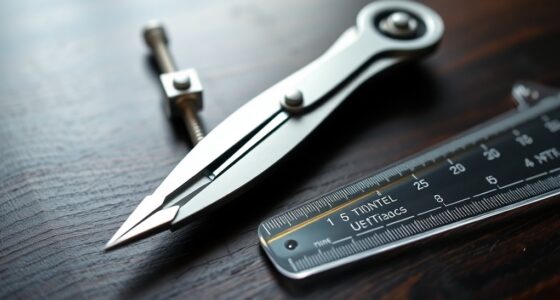Setting up a home math lab involves choosing essential tools like graphing calculators, geometric instruments, and visual aids with clear labels and color coding. Organize your space with designated zones for problem-solving, storage, and activities, keeping everything accessible and clutter-free. Use hands-on materials like puzzles, blocks, and measurement challenges to boost engagement. Incorporate technology and create a dedicated resource area for books and posters. With good planning, your math environment will inspire curiosity—keep exploring for more tips.
Key Takeaways
- Organize essential tools like graphing calculators, geometric supplies, and visual aids in dedicated, labeled zones for easy access.
- Create a clutter-free workspace with clear storage solutions such as labeled bins and modular shelves to enhance focus.
- Incorporate hands-on activities, puzzles, and a cozy reading nook to foster engagement and experiential learning.
- Utilize digital tools and apps for interactive practice, assessments, and tracking progress to maintain motivation.
- Prioritize safety by arranging workspace ergonomically, inspecting tools regularly, and having emergency supplies readily available.
Essential Mathematical Tools and Supplies

To effectively set up your home math lab, you need to gather essential mathematical tools and supplies that will support a wide range of activities. Start with a reliable graphing calculator, which is vital for exploring complex functions, data analysis, and visualizing graphs. Alongside this, geometric tools like a compass, protractor, and ruler are crucial for constructing accurate diagrams and understanding spatial relationships. These tools enable you to work on geometry problems, create precise drawings, and develop a deeper understanding of shapes and angles. Additionally, consider acquiring a scientific calculator, graph paper, and a calculator app if needed. Having these core supplies ensures you’re prepared for various math tasks, from algebra and geometry to calculus, making your home lab versatile and effective. Incorporating precise measurement tools can further enhance your ability to explore mathematical concepts with accuracy and confidence.
Organizing Your Workspace for Efficiency

To make your math lab work smoothly, start by creating designated zones for different activities, like problem-solving and material storage. Use smart storage solutions to keep supplies organized and accessible, so you don’t waste time searching. Keep your space clutter-free to stay focused and maximize your efficiency during every session. Incorporate consistent messaging in your setup to reinforce your learning goals and maintain motivation.
Designate Clear Zones
Have you ever noticed how clutter can slow down your workflow? To stay efficient, designate clear zones in your math lab. Use color coded zones to differentiate areas, making it easier to focus and find supplies quickly. Establish designated activity areas for problem-solving, reading, and storage. This helps prevent mixing tasks and keeps your workspace organized. Here’s an example layout:
| Zone | Purpose | Color |
|---|---|---|
| Problem-solving | Math exercises & work | Blue |
| Supplies | Tools & manipulatives | Green |
| Reading/Review | Textbooks & notes | Yellow |
| Storage | Extra materials & tech | Red |
Additionally, implementing organization principles can further enhance your workspace efficiency and help maintain a clutter-free environment.
Utilize Storage Solutions
Organizing your storage solutions effectively can dramatically boost your math lab’s efficiency. Use storage containers to keep supplies like rulers, protractors, and calculators neatly grouped. Clear containers make it easy to see what’s inside at a glance, saving time when searching for tools. Implement label systems on all containers and shelves to maintain order and prevent clutter. Label each storage container with its contents, such as “Geometry Tools” or “Math Games,” so you can quickly locate items. Consider stacking containers or using modular shelves to maximize space. Keep frequently used items accessible, and store less-used materials in higher or less obvious spots. Proper storage guarantees your workspace stays tidy and functional, allowing you to focus on learning and problem-solving without distraction. Regularly assessing your storage setup can help you identify clutter buildup and make necessary adjustments to keep your workspace organized and efficient.
Maintain Clutter-Free Space
Keeping your workspace clutter-free is essential for maintaining focus and boosting productivity in your math lab. When you prioritize clutter reduction and proper storage organization, you create an environment that encourages concentration. Use clear bins and labeled containers to keep tools and supplies accessible. Regularly sort through materials to discard what’s unnecessary. Designate specific areas for different activities to avoid chaos. Keep frequently used items within arm’s reach, and store rarely used resources elsewhere. Maintain a clean desk by putting away supplies after each session. Implement a simple filing system for worksheets and notes. Additionally, incorporating organized storage solutions can further optimize your space. By consistently organizing your space, you’ll reduce distractions and streamline your workflow, making your home math lab a more efficient and enjoyable environment.
Incorporating Visual Aids and Manipulatives

Choosing the right visual aids can make complex concepts easier to grasp. Organizing your manipulatives guarantees they’re accessible and ready to use whenever needed. By selecting effective visuals and keeping your resources tidy, you create an engaging and efficient learning environment. Incorporating Kia Tuning options can also inspire creativity and interest in your lessons.
Selecting Effective Visuals
Selecting effective visuals is essential for helping students understand complex mathematical concepts. Your goal is to make abstract ideas tangible through clear, engaging visuals. Use charts and diagrams to illustrate relationships, patterns, and processes, making information easier to grasp. Incorporate visual storytelling by creating step-by-step visuals that guide learners through problem-solving. When choosing visuals, consider:
- Clear labels and simple designs
- Color coding to highlight key points
- Interactive diagrams for engagement
- Real-world images to connect ideas
- Consistency in style for coherence
These tools make learning more dynamic and accessible. Well-chosen visuals not only clarify concepts but also boost confidence, encouraging students to explore math with curiosity and clarity. Incorporating layering textures and colors can further enhance the inviting atmosphere of your math lab.
Organizing Manipulative Resources
Organizing manipulative resources effectively is essential for creating a productive home math environment. Proper storage solutions keep your materials accessible and prevent clutter. Use bins, shelves, or drawer organizers to categorize items like counters, geometric shapes, and digital tools. Label each container clearly to save time searching. Implement a dedicated area or cart for quick access during lessons. Consider digital tools like tablets or apps that complement physical manipulatives, enhancing engagement. A well-organized setup encourages independent exploration and smooth lesson flow. Here’s a simple layout:
| Visual Aids | Physical Manipulatives | Digital Tools |
|---|---|---|
| Posters | Counters & Blocks | Math Apps |
| Charts | Geometric Shapes | Interactive Software |
| Flashcards | Fraction Tiles | Virtual Manipulation Tools |
This arrangement streamlines your resources, making math time efficient and engaging. Additionally, incorporating visual aids that are easy to update and customize can greatly improve student understanding and motivation.
Using Technology to Enhance Learning

Integrating technology into your home math lab can substantially enhance your learning experience by providing interactive and immediate feedback. Using interactive apps, you can explore concepts visually, making abstract ideas more tangible. Digital assessments allow you to track progress and identify areas needing improvement effortlessly. To maximize benefits:
Enhance your home math lab with interactive apps, visual tools, and digital assessments for engaging, personalized learning.
- Utilize apps that adapt to your skill level
- Incorporate online quizzes for instant feedback
- Use virtual manipulatives for hands-on practice
- Track progress with digital progress reports
- Explore math games that reinforce concepts
- Consider the importance of high-quality projectors contrast ratio for clear, vibrant visuals during lessons.
These tools keep you engaged and motivated while providing personalized learning pathways. By leveraging technology, you create a dynamic environment that supports self-paced, interactive learning, making your home math lab more effective and enjoyable.
Creative Ideas for Hands-On Activities

Building on the benefits of technology, hands-on activities bring math concepts to life by offering tangible, engaging experiences. You can create interactive puzzles that challenge problem-solving skills and spark curiosity. Math storytelling turns abstract ideas into relatable stories, making concepts memorable. Use everyday objects to design activities like pattern sorting or geometric shape hunts. These activities foster critical thinking and keep learners motivated. To inspire you, here’s a quick overview:
| Activity Type | Description |
|---|---|
| Interactive puzzles | Develop puzzles that require logical reasoning and collaboration. |
| Math storytelling | Craft stories around math concepts to make lessons memorable. |
| Shape scavenger hunts | Find geometric shapes around the house. |
| Pattern creation | Use beads or blocks to build repeating patterns. |
| Measurement challenges | Measure household items and compare sizes. |
Engaging in these activities can also support educational equity by making math accessible and enjoyable for diverse learners.
Setting Up a Reading and Resource Area

Creating a dedicated reading and resource area in your home encourages curiosity and supports independent learning. To make this space effective, focus on a cozy reading nook with comfortable seating and good lighting. Curate a diverse book selection that appeals to different interests and skill levels, including math-related titles and reference materials. Add accessible storage for easy organization and frequent updates. Use inspiring posters or educational decor to make the space inviting. Consider incorporating a small desk or table for activities and note-taking. Keep the area tidy and well-stocked, so your child feels motivated to explore and learn independently. A thoughtfully set up reading nook fosters a love for reading while providing quick access to essential resources for math and beyond.
Tips for Maintaining Engagement and Curiosity

To keep your child excited about math, regularly introduce new challenges that match their interests and skill level. Use interactive experiments to make abstract concepts tangible and fun. For example, hands-on activities like measuring ingredients or building shapes keep their attention and deepen understanding. Incorporate curiosity prompts by asking open-ended questions like, “What happens if…?” or “Why do you think that?” to spark their natural inquisitiveness. Vary the types of activities to prevent boredom and encourage exploration. Celebrate their successes and offer gentle guidance when they encounter difficulties. By keeping the challenges fresh and engaging, you foster a love of learning and curiosity that motivates ongoing discovery in your home math lab. Additionally, integrating creative problem-solving exercises can further enhance their cognitive flexibility and enthusiasm for learning.
Safety Considerations and Practical Tips

Ensuring safety in your home math lab is essential to prevent accidents and create a secure learning environment. Always wear protective gear, like safety glasses or gloves, when handling sharp tools or chemicals. Keep emergency procedures, such as first aid kits and fire extinguishers, easily accessible. Arrange your workspace to reduce hazards by clearing clutter and securing loose cords. Regularly inspect tools and equipment for damage to avoid malfunctions. Educate yourself on proper handling techniques and establish clear rules for safe practice. Remember to supervise children closely and store hazardous materials out of reach. Practicing these safety considerations guarantees a productive, accident-free environment where learning can thrive. Taking these practical steps helps protect everyone involved in your home math lab. Additionally, understanding angel numbers can provide spiritual guidance and reassurance during your setup process.
Frequently Asked Questions
How Can I Customize My Home Math Lab for Different Age Groups?
To customize your home math lab for different age groups, focus on age-appropriate activities that challenge without overwhelming. Use adaptable materials like adjustable puzzles or modular manipulatives so you can modify difficulty levels easily. You can also incorporate engaging tools like digital apps for older kids and hands-on games for younger learners. This approach guarantees each age group stays interested and benefits from tailored, stimulating math experiences in your home setup.
What Are Budget-Friendly Alternatives for Expensive Math Tools?
Did you know that 60% of educators use DIY manipulatives to save costs? You can try making your own with household items, like bottle caps for counters or string for geometric shapes. Online resource substitutions, such as free virtual math tools or printable worksheets, also offer budget-friendly options. These alternatives make math engaging without breaking the bank, helping you create an effective and affordable learning environment at home.
How Often Should I Update or Refresh Resources in My Math Lab?
You should refresh your digital resources and hands-on activities regularly, about every few months or when you notice they’re outdated or no longer engaging. Keeping your materials current keeps your math lab exciting and effective. Check for new apps, videos, or activities that can enhance understanding. Also, update resources based on your progress and interests, ensuring you always have fresh tools to inspire learning and curiosity.
What Strategies Encourage Independent Learning in a Home Setting?
To encourage independent learning at home, use motivational techniques like goal-setting and reward systems to keep you engaged. Incorporate peer collaboration through online study groups or forums, which boost accountability and understanding. Break complex problems into manageable steps, and regularly review progress to stay motivated. By combining these strategies, you create an environment that promotes self-driven learning, helping you build confidence and deepen your math skills effectively.
How Do I Assess Progress and Effectiveness of My Math Activities?
Did you know that students who regularly track their progress improve faster? To assess your math activities, try diverse assessment methods like quizzes, self-reflections, and problem-solving tasks. Use progress tracking tools, such as charts or journals, to monitor improvement over time. This way, you’ll identify strengths and gaps, adjusting activities as needed for better learning outcomes. Consistent evaluation keeps you motivated and guarantees your efforts are effective.
Conclusion
With your home math lab set up, you’re ready to open endless possibilities. Embrace the tools, organize with purpose, and let curiosity be your guide. Remember, every challenge is a stepping stone, every mistake a lesson. As you nurture this space, you’ll find that learning becomes a journey, not just a task. So, open your doors to discovery—your math adventure awaits, waiting for you to take that first confident step.









